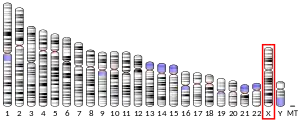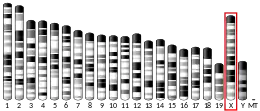| STARD8 | |||||||||||||||||||||||||||||||||||||||||||||||||||
|---|---|---|---|---|---|---|---|---|---|---|---|---|---|---|---|---|---|---|---|---|---|---|---|---|---|---|---|---|---|---|---|---|---|---|---|---|---|---|---|---|---|---|---|---|---|---|---|---|---|---|---|
| Identifiers | |||||||||||||||||||||||||||||||||||||||||||||||||||
| Aliases | STARD8, ARHGAP38, DLC3, STARTGAP3, StAR related lipid transfer domain containing 8 | ||||||||||||||||||||||||||||||||||||||||||||||||||
| External IDs | OMIM: 300689 MGI: 2448556 HomoloGene: 22837 GeneCards: STARD8 | ||||||||||||||||||||||||||||||||||||||||||||||||||
| |||||||||||||||||||||||||||||||||||||||||||||||||||
| |||||||||||||||||||||||||||||||||||||||||||||||||||
| |||||||||||||||||||||||||||||||||||||||||||||||||||
| |||||||||||||||||||||||||||||||||||||||||||||||||||
| |||||||||||||||||||||||||||||||||||||||||||||||||||
| Wikidata | |||||||||||||||||||||||||||||||||||||||||||||||||||
| |||||||||||||||||||||||||||||||||||||||||||||||||||
StAR-related lipid transfer domain protein 8 (STARD8) also known as deleted in liver cancer 3 protein (DLC-3) is a protein that in humans is encoded by the STARD8 gene[5][6] and is a member of the DLC family.
Structure and function
The protein is 1103 amino acids long, which like other DLC proteins consists of a sterile alpha motif (SAM), RhoGAP and a StAR-related lipid-transfer (START) domains.[7]
The protein is a Rho GTPase-activating protein (GAP), a type of protein that regulates members of the Rho family of GTPases. STARD8 is characterized as activating Rho GTPases. Its expression inhibits the growth of human breast and prostate cancer cells in culture.[7]
Tissue distribution and pathology
The protein is expressed in tissues throughout the body, but is absent or reduced in many kinds of tumor cells.[7]
While there are no known disorders caused by STARD8, partial loss of the STARD8 gene occurs in cases of craniofrontonasal syndrome where the EFNB1 gene (which causes the syndrome) is completely deleted.[8][9]
References
- 1 2 3 GRCh38: Ensembl release 89: ENSG00000130052 - Ensembl, May 2017
- 1 2 3 GRCm38: Ensembl release 89: ENSMUSG00000031216 - Ensembl, May 2017
- ↑ "Human PubMed Reference:". National Center for Biotechnology Information, U.S. National Library of Medicine.
- ↑ "Mouse PubMed Reference:". National Center for Biotechnology Information, U.S. National Library of Medicine.
- ↑ "Entrez Gene: StAR-related lipid transfer (START) domain containing 8".
- ↑ Nagase T, Seki N, Ishikawa K, Tanaka A, Nomura N (Feb 1996). "Prediction of the coding sequences of unidentified human genes. V. The coding sequences of 40 new genes (KIAA0161-KIAA0200) deduced by analysis of cDNA clones from human cell line KG-1". DNA Research. 3 (1): 17–24. doi:10.1093/dnares/3.1.17. PMID 8724849.
- 1 2 3 Durkin ME, Ullmannova V, Guan M, Popescu NC (Jul 2007). "Deleted in liver cancer 3 (DLC-3), a novel Rho GTPase-activating protein, is downregulated in cancer and inhibits tumor cell growth". Oncogene. 26 (31): 4580–9. doi:10.1038/sj.onc.1210244. PMID 17297465.
- ↑ Twigg SR, Matsumoto K, Kidd AM, Goriely A, Taylor IB, Fisher RB, Hoogeboom AJ, Mathijssen IM, Lourenco MT, Morton JE, Sweeney E, Wilson LC, Brunner HG, Mulliken JB, Wall SA, Wilkie AO (Jun 2006). "The origin of EFNB1 mutations in craniofrontonasal syndrome: frequent somatic mosaicism and explanation of the paucity of carrier males". American Journal of Human Genetics. 78 (6): 999–1010. doi:10.1086/504440. PMC 1474108. PMID 16685650.
- ↑ Wieland I, Weidner C, Ciccone R, Lapi E, McDonald-McGinn D, Kress W, Jakubiczka S, Collmann H, Zuffardi O, Zackai E, Wieacker P (Dec 2007). "Contiguous gene deletions involving EFNB1, OPHN1, PJA1 and EDA in patients with craniofrontonasal syndrome". Clinical Genetics. 72 (6): 506–16. doi:10.1111/j.1399-0004.2007.00905.x. PMID 17941886. S2CID 33823266.
Further reading
- Talmud PJ, Drenos F, Shah S, Shah T, Palmen J, Verzilli C, Gaunt TR, Pallas J, Lovering R, Li K, Casas JP, Sofat R, Kumari M, Rodriguez S, Johnson T, Newhouse SJ, Dominiczak A, Samani NJ, Caulfield M, Sever P, Stanton A, Shields DC, Padmanabhan S, Melander O, Hastie C, Delles C, Ebrahim S, Marmot MG, Smith GD, Lawlor DA, Munroe PB, Day IN, Kivimaki M, Whittaker J, Humphries SE, Hingorani AD (Nov 2009). "Gene-centric association signals for lipids and apolipoproteins identified via the HumanCVD BeadChip". American Journal of Human Genetics. 85 (5): 628–42. doi:10.1016/j.ajhg.2009.10.014. PMC 2775832. PMID 19913121.
- Qian X, Li G, Asmussen HK, Asnaghi L, Vass WC, Braverman R, Yamada KM, Popescu NC, Papageorge AG, Lowy DR (May 2007). "Oncogenic inhibition by a deleted in liver cancer gene requires cooperation between tensin binding and Rho-specific GTPase-activating protein activities". Proceedings of the National Academy of Sciences of the United States of America. 104 (21): 9012–7. Bibcode:2007PNAS..104.9012Q. doi:10.1073/pnas.0703033104. PMC 1868654. PMID 17517630.
- Twigg SR, Matsumoto K, Kidd AM, Goriely A, Taylor IB, Fisher RB, Hoogeboom AJ, Mathijssen IM, Lourenco MT, Morton JE, Sweeney E, Wilson LC, Brunner HG, Mulliken JB, Wall SA, Wilkie AO (Jun 2006). "The origin of EFNB1 mutations in craniofrontonasal syndrome: frequent somatic mosaicism and explanation of the paucity of carrier males". American Journal of Human Genetics. 78 (6): 999–1010. doi:10.1086/504440. PMC 1474108. PMID 16685650.
- Kawai K, Kiyota M, Seike J, Deki Y, Yagisawa H (Dec 2007). "START-GAP3/DLC3 is a GAP for RhoA and Cdc42 and is localized in focal adhesions regulating cell morphology". Biochemical and Biophysical Research Communications. 364 (4): 783–9. doi:10.1016/j.bbrc.2007.10.052. PMID 17976533.
- Bailey SD, Xie C, Do R, Montpetit A, Diaz R, Mohan V, Keavney B, Yusuf S, Gerstein HC, Engert JC, Anand S (Oct 2010). "Variation at the NFATC2 locus increases the risk of thiazolidinedione-induced edema in the Diabetes REduction Assessment with ramipril and rosiglitazone Medication (DREAM) study". Diabetes Care. 33 (10): 2250–3. doi:10.2337/dc10-0452. PMC 2945168. PMID 20628086.



